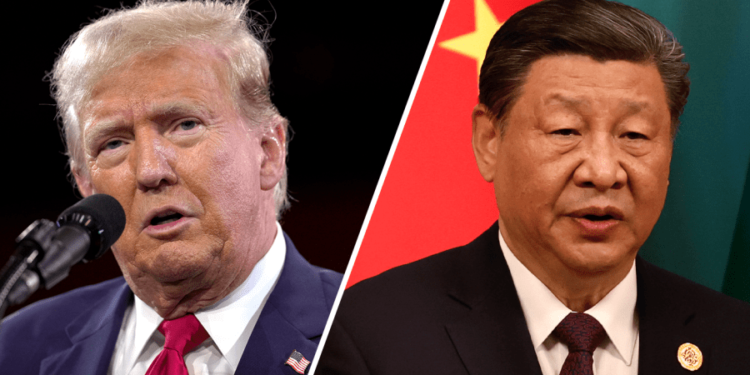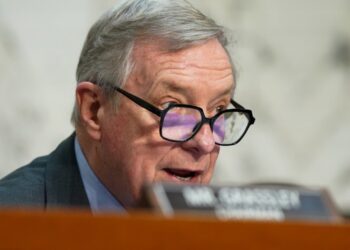
Former President Trump is going all in on the idea of tariffs as a way of lifting the U.S. economy, bucking criticism from think tanks, labor and big business alike.
Trump’s plans include a general tariff on imported goods and an additional tariff specific to imports from China, one of the US’s main trading partners. So far, Trump hasn’t talked much, if at all, about exemptions to his proposed tariffs, which could grate against trade deals the US has with many different countries.
Here’s what Trump says he would do in a second term, and what his supporters and critics say of those plans.
A 10-20 percent tax on all foreign goods
Trump has variously proposed a general tariff of 10 percent and 20 percent on all imported goods in order to pull investment into the U.S. and bolster domestic industry.
Such a move would be a significant escalation of Trump’s protectionist trade policies, which included steep tariffs on Chinese goods and a renegotiation of NAFTA during his first term.
“It’s going to have a massive effect — positive effect. It’s going to be a positive effect,” Trump said during an interview at the Economic Club of Chicago last week.
“It must be hard for you to spend 25 years talking about tariffs as being negative and then have somebody explain to you that you’re totally wrong.”
Economists caution that a general tariff could run afoul of many existing trade agreements with potentially retaliatory consequences, even for longstanding U.S. trade partners.
“Trying to understand whether this will affect countries that we have … free trade agreements with is one of the many mind-boggling things to contemplate,” Jason Furman, who chaired the White House Council of Economic Advisers (CEA) under former President Obama, said during an online symposium last week.
“[Trump] has not talked at all about exempting them, but we have an actual agreement with Canada and Mexico. We have agreements with about a dozen or more other countries that are similar to that.”
Trump has talked about replacing the income tax with tariffs as a central pillar of the federal revenue architecture, and while there are major doubts about the feasibility of this, experts on U.S. fiscal policy are taking him seriously.
“Trump has even revived the notion – against all logic and available evidence – that tariffs could once again be made the foundation of federal finance,” US fiscal policy historian Joseph J. Thorndike wrote.
“For all its antiquated assumptions, we should take Trump’s vision of a tariff-only tax system seriously (if not literally). It might play a role in tax reform debates next year,” he wrote.
A 60-percent tariff on Chinese goods
Trump has floated a 60-percent tariff on all goods from China, one of the top U.S. trading and financial partners.
China is the U.S.’s top source of imports, with 16.5 percent or $536 billion of goods imported from the country out of $3.2 trillion in total goods in 2022, according to the U.S. Trade Representative. U.S. goods imports from the European Union were $553 billion in that year. Other top goods exporters to the U.S. include Mexico, Canada, Japan, and Germany.
China also held $775 billion worth of U.S. securities in August, second only to Japan at $1.1 trillion, closely linking the countries through financial markets.
Chinese authorities told The Hill they don’t want a trade war and stressed the importance of the stability of production and supply chains.
“Restrictions or protectionism will only disrupt normal trade flows and the stability of the production and supply chain, which serves the interests of no one. The US side should earnestly respect the principles of market economy and international trade rules and create a good environment for China-US economic and trade cooperation,” Chinese embassy spokesperson Liu Pengyu said in a statement to The Hill.
U.S. businesses are also concerned about disruptions that could result from a general tariff. Seventy-five percent of executives said a 10-percent general goods tariff would “significantly hinder their company’s growth,” according to a recent survey by accounting firm PwC.
Threats of steeper tariffs to bring back jobs
Trump views tariffs as being able to protect American industries and jobs.
“The higher the tariff, the more likely it is that the company will come into the United States and build a factory in the United States so it doesn’t have to pay the tariff,” Trump said in Chicago last week.
Certain tariffs and the prohibition of market access can certainly be favorable to specific industries, as in the case of recent Chinese electric vehicle exclusions set by the Biden administration. But the link between higher tariffs and more high-paying domestic jobs, particularly in manufacturing, is contentious among economists.
Many believe there is very little correlation there at all, especially since the U.S. has been near full employment for nearly a decade, notwithstanding the immediate aftermath of the pandemic. Even as industries can be supported by tariffs, it’s up to company managers whether and where they want to hire staff, purchase more automated equipment, or make changes to production levels.
Even labor unions — who fought tooth and nail against free-trade deals, which many blame for a steep decline in U.S. manufacturing — have doubts about the benefits of tariffs for workers.
“There has been a misconception that we’ve been out there — particularly our manufacturing unions — trying to really explain,” Fred Redmond, secretary-treasurer of the AFL-CIO labor federation, said during an event last week. “It’s been an eye-opener to some of our members that tariffs are not the answer to higher costs, because those costs are eventually passed on to the consumer.”
Redmond added that labor’s participation in recent trade discussions with the USTR has made a “huge difference” in how unions approach trade.
What Trump can do without Congress
Congress has power over taxation and the collection of duties, has increasingly delegated authority on tariffs to the executive branch since the 1930s.
One recent law gives the president the power “to proclaim limited changes to U.S. tariff rates without further congressional action,” according to a recent legal summary by the Congressional Research Service (CRS).
This means that Trump, if he wins the presidency, has a good deal of leeway to turn his tariff ambitions into a reality.
Section 301 of the Trade Act of 1974 was taken special advantage of by Trump during his first term to advance his trade agenda.
Trump “was more willing than previous officials to act unilaterally under these authorities,” CRS noted earlier this year.
“A president willing to exercise [their] discretion is going to be hard to constrain,” Harvard University trade economist Robert Z. Lawrence recently told The Hill.
Experts are alarmed about inflation
Beyond the international agreements that could be called into question by Trump’s tariffs as well as their feasibility as a source of revenue, economists are also concerned about the potentially inflationary effects of a general import tax.
“If you look at U.S. consumers, obviously we went through a big inflation period, but whatever voters are upset about, they’re upset about the fact that prices are higher,” Peterson Institute of International Economics senior fellow Maurice Obstfeld observed last week.
“Inflation is down,” he continued. “They’re not saying, ‘That’s so great. We forgive the Biden administration.’ They’re pissed because prices are higher – and tariffs are going to raise prices.”
Economists polled by the Wall Street Journal expect Trump’s proposed tariffs and tax cuts to fuel higher inflation and steeper deficits while slowing U.S. economic growth. Analysts at Moody’s Analytics also projected Trump’s tariffs, tax cuts and plans for mass deportations to take a serious toll on prices and the broader economy.
Trump, however, has dismissed the concerns of the economic establishment, pointing to the impact of free-trade deals on industrial U.S. states.
“What does The Wall Street Journal … they’ve been wrong about everything,” Trump said before turning his ire on his interviewer, Bloomberg News editor-in-chef John Micklethwait.
“So have you, by the way.”







